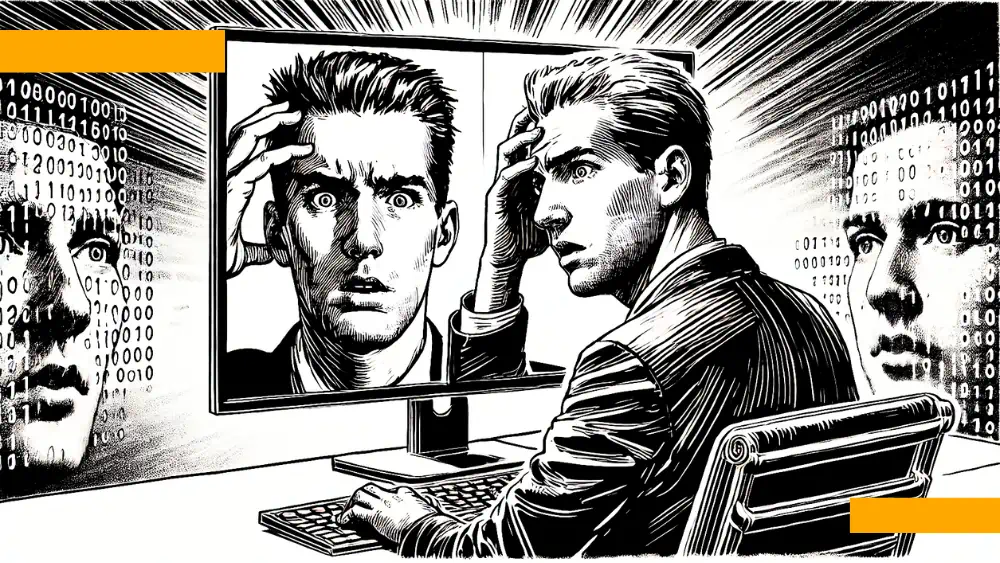 illustration: DALL-E
illustration: DALL-EResearchers Qiang Liu, Lin Wang, and Mengyu Luo from the University of Science and Technology in Shanghai set out to examine how deepfake technology affects the perception of information and users` trust in media. In their article When Seeing Is Not Believing: Self-efficacy and Cynicism in the Era of Intelligent Media, published in Humanities and Social Sciences Communications, they conducted two experiments involving 1,826 participants, analyzing how cynicism toward information changes depending on users` ability to recognize AI-generated content.
The experiments revealed that:
- Individuals with low self-assessment in recognizing AI content are more likely to question the authenticity of news that is personally significant to them.
- Low-risk content paradoxically raises more skepticism than content considered high-risk.
- Users who repeatedly struggle to assess the authenticity of deepfakes lose confidence in their abilities and abandon efforts to verify information.
This phenomenon leads to the so-called "apathetic reality," where audiences choose indifference over critical thinking regarding media consumption.
Why Are We Losing Trust in Media?
The growing cynicism toward AI-generated information is not just a technological issue but also a matter of how audiences process content. Research suggests that users engage more in content analysis when they feel the topic directly affects them.
Data shows that:
| Factor | Impact on AI Self-Assessment | Impact on Cynicism |
|---|---|---|
| High content relevance | Increased confidence | Reduced cynicism |
| Low content relevance | Decreased confidence | Increased cynicism |
| High-risk news | Greater inclination to verify | Lower level of cynicism |
| Low-risk news | Less interest in verification | Higher level of cynicism |
The study`s authors highlight the effect of cognitive fatigue. When users repeatedly encounter situations where they cannot distinguish deepfakes from real content, they stop making an effort to check. Ultimately, instead of verifying authenticity, they begin treating all information as potentially unreliable.
What Can We Do?
Experts emphasize that the solution lies not only in developing deepfake detection technologies but also in shaping new media literacy models.
- Social media platforms should implement more advanced mechanisms for labeling AI-generated content.
- Users should be trained not only in recognizing fake news but also in consciously processing information in an era of informational chaos.
- Journalists should make greater use of content verification tools and build communication strategies based on source transparency.
Liu, Wang, and Luo`s study found that even a small increase in users` self-confidence regarding AI leads to a significant reduction in cynicism and greater engagement in content analysis. This means that education and tools supporting content verification can help audiences regain control over what they consider true.
The Future of Trust in Information
Deepfake news is a challenge we will face for years to come. In the age of artificial intelligence, it is not just technology that determines what we believe but also our ability to recognize and critically analyze content. If we do not begin developing skills to navigate the world of synthetic information, we may find ourselves in a reality where we cannot even trust what we see with our own eyes.
* * *
Article by Liu, Q., Wang, L., Luo, M. (2025) When Seeing Is Not Believing: Self-efficacy and Cynicism in the Era of Intelligent Media, published in Nature Humanities and Social Sciences Communications, available at
https://www.nature.com/articles/s41599-025-04594-5
COMMERCIAL BREAK
New articles in section Media industry
Advertising market 2025. Poland, Europe and the World
Marcin Grządka
The global advertising market is growing by 8.8% in 2025 and will reach a value of 1.14 trillion dollars. The industry result in Europe records slightly lower dynamics, at the level of 5.8%. In this comparison, Poland performs clearly above the average. We will record an increase of 8.9% this year and a value of 18.56 billion PLN - estimates WPP Media in the annual report "This Year Next Year".
The print media market 2025. Three global trends
Krzysztof Fiedorek
The market value is 359.53 billion dollars, yet the erosion is visible to the naked eye. The decline for newspapers will amount to -2.3 percent. Despite this, print retains strength: it generates 76 percent of subscription revenues and enjoys 82 percent consumer trust. The future of the industry is defined by hybrid strategies and niche specialization.
Journalism in the age of AI. Why people prefer humans over machines
Krzysztof Fiedorek
Only 12% of people accept news created solely by AI, while 62% prefer those written by humans. At the same time, only 19% notice labels indicating the use of artificial intelligence, while younger audiences ask AI to explain the content to them. These are the findings of the Reuters Institute report on artificial intelligence in media.
See articles on a similar topic:
Review of media from around the world. See what they are buzzing about [LINK]
AUTOPROMOCJA Reporterzy.info
What is the media buzzing about? A review of the headlines of the most important newspapers and websites. Events of the day, country, world, media market, economy, sport, foreign media, and even gossip and curiosities. In real time and 24 hours a day. We invite you!
Disinformation ranks above terrorism as global threat
KFi
According to "International Opinion on Global Threats" by Pew Research Center, a median of 72% of adults across 25 countries view the spread of false information online as a major threat to their country. That number places disinformation at the very top of perceived global dangers.
DAB+ Radio. What is Digital Radio Broadcasting?
Krzysztof Fiedorek
Digital radio broadcasting technology, compared to traditional analog radio, provides higher sound quality, better resistance to interference, and more additional features during transmission. However, it’s not without drawbacks and raises concerns among broadcasters.
Yellow Press. What is Yellow Journalism?
Krzysztof Fiedorek
The terms "yellow press" and "yellow journalism" are often used pejoratively to describe journalistic practices focused on sensationalism, gossip, and emotions rather than objective facts. Let’s explore their origins, distinctive features, and impact on society.





























